|
India
Inc., take a bow. For, however much macroeconomists may try to explain
away the general optimism all around us, and the economic boom by
proffering statistics related to the monsoon and interest rates,
fact is, much of the feel-good thing stems from a resurgent India
Inc. Companies, as all publications, including the one in your hand,
have pointed out, are returning never-before profits, many of them
on increased revenues. It wasn't easy picking the fastest growing
companies of 2003-04, but here, on the basis of a rigorous methodology
involving revenue, operating profit, and net profit growth (See
How We Did It) are the winners. Since every industry has its quirks,
we've chosen to arrange them alphabetically, although a growth-based
ranking can be found on page 80. Now, read on, as the rest of India
Inc. eats the dust of the leaders.
-Narendra Nathan
 |
| Sanjay Labroo/CEO/ Asahi: They don't do
it with mirrors; they use glass |
ASAHI INDIA GLASS
It's All Reflected Glory
Sanjay Labroo is happy. Not just
because Asahi India Glass has just announced a net profit of Rs
17.5 crore for the three months ended December 31, 2003-it did Rs
3.4 crore for the same period last year, but that was before it
acquired Floatglass India-but because he sees signs of growth all
around: new high-rises and crowded car parks. Glass is the new concrete,
claims an Asahi ad and the construction activity around Labroo's
office in Gurgaon bears this out. Most cars made in India use Asahi
glass, and the company's second factory for automotive glass is
coming up near Chennai. Better still, Labroo is convinced there
is an opportunity in exports. "After all, we are a low-cost,
high-skill, and high-production base," he says.
-Kushan Mitra
 |
| M.S. Ramachandran/CMD/IOC: Providence,
and a dash of marketing savvy helped |
BONGAIGAON REFINERY & PETROCHEMICALS
With A Little Help From Friends
BRPL has a chairman and managing Director
(CMD), but it is M.S. Ramachandran, CMD, Indian Oil Corporation,
which acquired a 74 per cent stake in it in 2001, who calls the
shots. Helped by government decisions halving the excise duty on
refineries in the North East by half and allowing BRPL to source
oil from Andhra's Ravva oil-fields (the Assam fields are virtually
dry and the refinery has never run to capacity in the past) and
by IOC's marketing clout, BRPL returned a net profit of Rs 178.45
crore in 2002-03 as compared to losses of Rs 237 crore the previous
year. Bravo!
-Ashish Gupta
 |
| Vinod Dasari/Joint Managing Director/ Cummins:
Can't make enough engines! |
CUMMINS INDIA
Growth Engine
India shining has meant more business
for Cummins India-engines are somehow linked to economic growth-but
it is exports that are clearly responsible for the company's faster-than-faster
growth. Last year, these accounted for 20 per cent of Cummins' revenues
of Rs 800 crore and the company expects them to grow by 30-40 per
cent every year, helped along by outsourcing orders from the parent.
"We shall now be meeting the entire global requirements for
V-28 and K-38 engines from here in India," says Vinod Dasari,
Joint Managing Director, Cummins India. Focus (the company concentrates
on maximising volume and minimising volatility in demand) and cost
reduction initiatives have also played a part in the company's success.
"We are selling engines faster than we can make them,"
gushes an upbeat Dasari.
-Abir Pal
 |
| T.R. Mehta/Managing Director/Flat Products:
Riding the steel boom |
FLAT PRODUCTS EQUIPMENTS (INDIA)
A Core Of Steel
Those not in the know may be tempted
to write off the growth of Flat Products Equipment-a steel plant
installer-as fallout of the steel boom in India. That would be only
partially right. For, by cutting teeth on local plants and allying
with the right international companies-T Sendzimir Inc. of the US
for cold rolling mills and France's Redex for stretch levelling
equipment, for example-the company has managed to position itself
as a global player. "We are recognised as a supplier of international
quality equipment at competitive prices and this has resulted in
large export orders," says T.R. Mehta, MD, Flat Products. Predictably,
the company's order book of Rs 600 crore includes orders from Taiwan,
China, Indonesia, Egypt, and Korea. That should explain the 265.7
per cent increase (to Rs 91.97 crore) in revenues the company posted
for the three months ending September 30, 2003.
-Dipayan Baishya
 |
| Kuldeep Kaura/Managing Director/ HZL: Shining
Zinc |
HINDUSTAN ZINC
A Private Matter
There's a non-ferrous metals boom
on, as evident in the rising price of zinc on the London Metals
Exchange. That, though, isn't the only thing behind Hindustan Zinc
Limited's (HZL) comeback. And what a comeback it has been: in the
nine months ending December 31, 2003, the company registered revenues
of Rs 1,324.3 crore and earned a net profit of Rs 318.7 crore; the
corresponding figures for the previous year were Rs 910.3 crore
and Rs 95.3 crore. The real reason for the turnaround is the fact
that the erstwhile public sector company passed into private hands
(Sterlite) in April 2002. "An increase in productivity through
de-bottlenecking of plants and cost controls has helped us grow
fast," says Kuldeep Kaura, Managing Director, HZL. And how!
-Roshni Jayakar
ELGI EQUIPMENTS
Compressed Logic
Like so many other companies in this
listing, Elgi, a Coimbatore-based engineering and capital goods
company, can credit its fast growth to a booming economy. Its customers
include companies in the automotive, paints, engineering, cement,
and petrochemical sectors. Still, there's only so much the company
can grow in India: it boasts a 35 per cent share in a market that
represents a mere 1 per cent of the global demand for compressors.
"That means our global marketshare is only 0.35 per cent,"
says L.G. Varadarajulu, Chairman, Elgi, putting things in perspective.
His argument: it is far easier to try and double this than grow
share in India. That's exactly what the company is doing: in September
2003, it received a certification that will allow it to supply to
American railroads. And it has entered into an arrangement with
an American Fortune 500 company to supply 45,000 air compressors.
"We will benefit from building volume-based competencies into
our manufacturing process," says Jairam Varadaraj, MD, Elgi.
He can say that again.
-Nitya Varadarajan
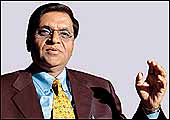 |
| Vijay Kumar Gupta/CMD/Gujarat Ambuja Exports:
The quiet exporter |
GUJARAT AMBUJA EXPORTS
Economies Of Export
Gujarat Ambuja Exports (2002-03 revenues:
Rs 621 crore) is one of those companies not too many people know
too much about. For the record, the company, which has seen its
net profit grow 161 per cent to Rs 16.97 crore in the first nine
months of 2003-04 as compared to the same period last year, exports
cotton yarn, oilseed, edible oils, starch and wheat products. And
as its Chairman and Managing Director Vijay Kumar Gupta, points
out, only 10 per cent of its revenues comes from trading operations
(the rest is from manufacturing), a statistic, he says, that indicates
the edge the exporter enjoys. Gujarat Ambuja Exports is still vulnerable
to the commodity cycle, but the company is forging ahead with expanding
capacities in the cotton yarn and maize-crushing business and has
established beach heads in Singapore and Sri Lanka. Whoa!
-Roshni Jayakar
 |
| Arun Kumar/President & MD/HSS: The
prudence-play |
HUGHES SOFTWARE SYSTEMS
Getting Better All The Time
It must not have been easy for Hughes
Software Systems to forsake the high ground of software product
development for the low ground of business process outsourcing and
software maintenance services. If it's any help, the growth post
this event has been exceptional: in the three months ending December
31, 2003, the company reported a 70 per cent increase in revenues
and a 110 per cent increase in net profit as compared to the corresponding
period last year. Not that the company has completely abandoned
the high ground. All through the downturn, it continued to spend
10 per cent of its turnover on R&D. "We have taken prudent
decisions without sacrificing the future," says Arun Kumar,
President and MD, HSS. It shows.
-Vandana Gombar
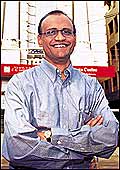 |
| E. Sudhir Reddy/Vice Chairman & Managing
Director/IVRCL: A mini-L&T in the making |
IVRCL INFRASTRUCTURE & PROJECTS
Water To Wealth
The Indian government's ambitious
golden quadrilateral (GQ) project has come as a boon to several
engineering and construction companies, including Hyderabad-based
IVRCL. However, what's really helped the company grow is its ability
to nab what are called 'water projects', large engineering initiatives
that have to do with water and sewage pipelines. The competition
is a lot less intense in this business, and there's enough work
going around. For instance, in 2003, IVRCL bagged a Rs 315.5-crore
project from the Tamil Nadu government (Chennai Water Supply Augmentation
Project) and a Rs 55-crore Gujarat Water Supply and Sewerage Board
one. With projects on hand for some Rs 3,500 crore, Vice Chairman
Sudhir Reddy hopes to close 2003-04 with revenues of Rs 700 crore.
-E. Kumar Sharma
 |
| P.T. Kuppuswamy/Chairman/Karur Vysya Bank:
Contrarian play |
KARUR VYSYA BANK
Counting on PSUs
Most banks that have grown rapidly
over the past couple of years attribute this to the booming retail-banking
business. Karur Vysya Bank, a Karur-based bank with deposits of
Rs 5,121.92 crore in 2002-03 (in terms of deposits the bank is the
forty fourth largest in the country), has always enjoyed significant
retail play, but the company's Chairman, P.T. Kuppuswamy, would
like to think something else is behind the bank's fast growth. "In
the past two years, we grabbed opportunities thrown up by public
sector companies (that were growing) and have been lending to them."
And with the economy on a song, the bank is hoping its traditional
strength of serving small and medium enterprises will help it grow
even faster. It should.
-Nitya Varadarajan
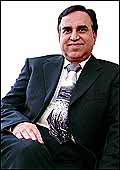 |
| R.C. Manusukhani/Chairman/Man Industries:
'Piping the world |
MAN INDUSTRIES (INDIA)
No Pipedream This
If 2001 saw Indian Telcos pump thousands
of kilometres of optic fibre into the ground, then, the past year-and-half
have belonged to oil and gas companies building pipeline networks.
Man Industries, a company that makes pipes supplies to pipelines
being constructed by GAIL, IOC, and ONGC. And it is involved in
several pipeline projects in West Asia, including some in Iraq.
Not surprisingly, the company is investing Rs 140 crore in a greenfield
facility at Anjar in Gujarat. "The dismantling of the administered
price mechanism (on petroleum products), gas discovery, the latent
gas demand, and the emphasis on the import of Liquified Natural
Gas (which will have to be piped from landing points) is leading
to a growing demand for gas transportation," says R.C. Mansukhani,
Chairman, Man Industries, who expects orders for 5,000-6,000 kilometres
of pipeline in the next five years. That's a bit.
-Dipayan Baishya
 |
| H.K. Mittal/CMD/Mercator: He's now looking
beyond India |
MERCATOR LINES
Crude Transportation
In India's shipping industry you can't
pick a strategy more conservative than Mercator Lines'. The company
acquires second-hand carriers at rock-bottom prices and charters
them to the Mumbai port and to other Indian and foreign companies.
However, its recent growth-its net profit for the three months ending
December 31, 2003, were 700 per cent higher than the corresponding
figure for 2002-can be traced to the government's decision in 2001,
to allow private shipping companies to transport crude. Between
April and November 2003, Mercator acquired four second-hand mid-sized
(around 90,000 tonnes) tankers for $31 million. The immediate provocation:
contracts from MRPL and IOC aggregating Rs 160 crore. Chairman H.K.
Mittal is now eyeing overseas opportunities and says the company
may even acquire a VLCC (very large crude carrier). "There
is significant under-supply in our industry," he says. "And
shipping markets like China present new opportunities." Evidently,
Mercator has the wind in its sails.
-Dipayan Baishya
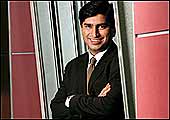 |
| Ratul Puri/ED/Moser Baer: The fruits of
strategy |
MOSER BAER INDIA
Optical Illusion
Moser Baer, one the world's five optical
media manufacturers of note-the other four are in Taiwan or Japan-owes
its growth to the insatiable demand for recordable CDs and DVDs.
However, it would be a mistake to attribute the company's good fortune
to happenstance: Moser Baer is where it is (a 18 per cent share
of the global market) because of two strategic decisions. The first
concerns its entry into the hi-tech and capital-intensive business.
To date, the company has invested $500 million in its manufacturing
facility at Noida, a Delhi satellite. The second is its focus on
being in the outsourced manufacturing business as opposed to the
contract manufacturing one (margins are lower here). Obviously,
both have paid off.
-Kushan Mitra
 |
| Kishore Biyani/Managing Director/Pantaloon
Retail : He's the Big B of retail in India |
PANTALOON RETAIL (INDIA)
Shopkeeper #1
Anyone who has set foot in any of
the eight big bazaars across seven Indian cities-three of these
opened for business in 2003-has already experienced, up close and
personal, the reason behind Pantaloon Retail's growth. In the first
six months of 2003-04, Pantaloon grew its revenues by 45 per cent;
net profit by 91 per cent. And the company's Chief Executive Kishore
Biyani promises that there will be no let up. "Last year was
the year of growth in our value-business," says Biyani. "This
year we will be concentrating on the life-style business."
On the ground, that translates into Central, a mall where Biyani
hopes to lease out retail space. The first of these, all 125,000
square feet of it, will open doors for business in March 2004. This
one is obviously a Big C.
-Dipayan Baishya
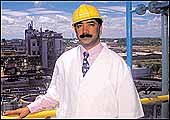 |
| Raghavendra Rao/Managing Director/Orchid:
Discovery-to-delivery aspirations |
ORCHID CHEMICALS & PHARMACEUTICALS
The Price of Regulation
Chennai-based Orchid-its revenues
for the first nine months of 2003-04 increased by 46 per cent and
net profit, by 144 per cent, over the same period in 2002-03-began
the new year well. It's year-old acquisition of Mano Pharma kicked
in (the company's financials will now be integrated into Orchid's)
doubling the size of its lucrative formulations business from Rs
60 crore last year to Rs 120 crore. In 2003, the prime driver of
Orchid's growth, says the company's Managing Director K. Raghavendra
Rao, was the shift from sales in unregulated markets to regulated
ones. Mumbai-brokerage SSKI estimates that increased sales in regulated
markets will result in a CAGR of 28 per cent between 2003 and 2007;
the corresponding estimate for net profit is 88 per cent. That's
some growth.
-Nitya Varadarajan
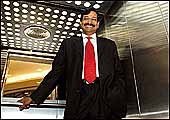 |
| Arun Jain/CEO/Polaris: Betting on a hybrid
product-service strategy |
POLARIS SOFTWARE LABS
After The Flood
There's a feeling in most quarters
that Polaris, a Chennai-based software major that was once spoken
of in the same breath as Infosys, TCS, Wipro, Satyam, and HCL Technologies
has never really got its due-from its peers, the media, and investors.
The arrest and detainment of its CEO Arun Jain in Indonesia over
a customer relationship that soured and teething troubles associated
with its merger with Orbitech haven't helped matters. However, most
analysts who track the it services sector believe the worst is behind
Polaris. Like Temenos and i-flex, Polaris has a banking product
Orbione. But unlike these companies, its strategy has more of the
services component. "Packaging the product with service offerings
will help us grow from a mere utility business to an enhancement
one," said Jain at a conference announcing the company's results
for the quarter ended December 31, 2003. The numbers? A 75 per cent
growth in revenues and a 48 per cent growth in profits in the first
nine months. That's impressive.
-Nitya Varadarajan
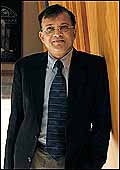 |
| Prithvi Jindal/Chairman/Saw Pipes: Iraq
is the honey-pot |
SAW PIPES
Pipes For Everyone
Prithvi Jindal knows that pipes are
not what one would term a 'sexy' industry, but sitting in his office
in New Delhi's Bhikaji Cama Place, he is not complaining: Saw Pipes
Limited has been growing at a frenetic pace. Revenues have grown
from Rs 313.4 crore in 1999-00 to Rs 807 crore in 2002-03. And with
the oil and gas sector picking up speed, with forecasts of both
larger energy (oil and natural gas) resources being discovered and
increased consumption, things are looking rather good. "You
know something, if I had Rs 1,000 crore to invest today, I would
invest it in the pipeline business, not making the pipes but operating
the pipelines; it is extremely profitable," says Jindal. The
man would like nothing better than to see Saw Pipes become a "total
pipe solutions" company. "People will always need pipes,"
he says. "We will be there."
-Kushan Mitra
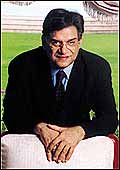 |
| Surinder Kapur/Chairman/Sona Koyo: Volumes,
he has; now he's making a value-play |
SONA KOYO STEERING SYSTEMS
Northbound
Lately he has been making all the
tabloids after his son, Sunjay married Bollywood heroine Karishma
Kapoor. But, Surinder Kapur runs one of India's largest automotive
component manufacturers, Sona Koyo Steering Systems Limited, and
with the automotive market set to touch a million passenger vehicles
this year, things are looking good. Sitting in his eighth floor
office in Gurgaon overlooking the factory of his largest client,
Maruti Udyog Limited, Kapur has his task cut out. He knows that
to reach the set target of Rs 450 crore in revenues by 2007, Sona
must export (it will, starting August 2004), restructure its costs,
and enter the high-value power-steering and electronic power steering
businesses. Still, as long as Indians keep buying cars (and watching
his daughter-in-law's movies), Kapur is sure to be happy.
-Kushan Mitra
STERLING BIOTECH
Encapsulating Growth
Sterling Biotech is the largest gelatin
maker in India and all Asia. That isn't saying much: the Indian
market for gelatin is limited and the company fights with global
biggies Sobel and PB Gelatin for share (Gelatin is used by the pharmaceutical
industry to make hard and soft capsules and in other medical applications).
Rather than merely focus on this market, Sterling has aggressively
sought international certification and built relationships with
global healthcare biggies such as Cardinal Health Inc. and Kenko
Corporation. Today, almost half its revenues come from exports.
Given its natural cost advantage, Sterling's net profits have been
on the ascendant. In the second quarter of 2003-04, for instance,
they increased by 186 per cent over the corresponding period in
2002-03. Expectedly, a Rs 236-crore investment in capacity expansion
is in the offing.
-Roshni Jayakar
 |
| Ratan Tata/Chairman/Tata Motors: Globalisation
is it |
TATA MOTORS
Stepping On The Gas
In the April-December 2003 period,
sales of Tata Motors' commercial vehicles surged by 44.5 per cent.
The truck maker isn't just growing faster than the industry; more
notably, it's recording such growth rates on volumes of 100,000
and above. Between April and December, Tata Motors sold 104,675
CVs. And for good measure 97,219 cars, which marks a 42 per cent
growth over 2002's corresponding nine-months. "This growth
is a result of bringing a slew of new products into the market.
Over the past 18 months, we must have brought 15 products (including
variants) to market," points out Praveen Kadle, Executive Director
(Finance), Tata Motors. Backing the new launches was a revamp of
the marketing and distribution network, a broadening of the export
base, and new global alliances such as the one with Rover of the
UK. That the new products are kicking in is evident from the increasing
marketshare figures across most segments: Tata Motors' share in
trucks, for instance, which had fallen to 66 per cent a couple of
years ago, is now up to 70 per cent.
-Brian Carvalho
 |
| Niru Mehta/Vice Chairman/Tata Telecom: Tapping
the BPO boom |
TATA TELECOM
Calling India
To morph from a retailer of small
exchanges (PBXs) to a successful provider of call-centre solutions
could not have been easy. Tata Telecom-a joint venture of the Tata
Group and Lucent spin-off Avaya-saw and seized the opportunity for
marketing such solutions ahead of the competition. Today, the company
boasts a 50 per cent share of the contact-centre market. Tata Telecom
also offers video-conferencing, virtual private networks and Voice
over Internet Protocol (VOIP) solutions for other corporates. "We
have all the basics right and are limited only by our own imagination
and ability to draw on the organisational and individual competencies
that we possess," says Niru Mehta, Vice Chairman, Tata Telecom
and the MD and Vice President of Avaya India. Next step: exports
and acquisitions.
Vandana Gombar
| HOW WE DID IT |
|
Step 1: Short listing
Only listed companies (BSE and NSE) traded within the last
week were considered. A cut off market capitalisation (December
31, 2003) of Rs 50 crore and a cut off sales of Rs 50 crore
for the three months ended September 30, 2003 were enforced.
A total of 483 companies made the cut. Only companies with
positive operating and net profit figures were considered.
Step 2: Measuring Growth
Growth was measured as a factor of net sales (operating income
for banks and finance companies), operating profit (profits
before depreciation and taxes for banks and before depreciation
interest and taxes for others), and net profit. The weightages
assigned were: 25 per cent for net sales for each quarter;
15 per cent for operating profit for the quarter ended September
30, 2003, and 10 per cent for the quarter ended June 30, 2003;
and 15 per cent for net profit for the quarter ended September
30, 2003; and 10 per cent for the quarter ended June 30, 2003.
Step 3: Adjustments
The operating profit and net profit figures have been arrived
at after discounting non-recurring income.
Step 4: The list
The list presented alongside has the 21 companies that beat
the average ranked in descending order. Their most recent
numbers have also been presented. |
|
